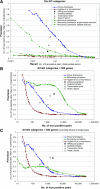Global analysis of gene function in yeast by quantitative phenotypic profiling
- PMID: 16738548
- PMCID: PMC1681475
- DOI: 10.1038/msb4100043
Global analysis of gene function in yeast by quantitative phenotypic profiling
Abstract
We present a method for the global analysis of the function of genes in budding yeast based on hierarchical clustering of the quantitative sensitivity profiles of the 4756 strains with individual homozygous deletion of nonessential genes to a broad range of cytotoxic or cytostatic agents. This method is superior to other global methods of identifying the function of genes involved in the various DNA repair and damage checkpoint pathways as well as other interrogated functions. Analysis of the phenotypic profiles of the 51 diverse treatments places a total of 860 genes of unknown function in clusters with genes of known function. We demonstrate that this can not only identify the function of unknown genes but can also suggest the mechanism of action of the agents used. This method will be useful when used alone and in conjunction with other global approaches to identify gene function in yeast.
Figures


 ). The characteristics of other high-throughput experimental data, affinity precipitation (▪), yeast two hybrid (
). The characteristics of other high-throughput experimental data, affinity precipitation (▪), yeast two hybrid ( ), synthetic lethality (
), synthetic lethality ( ), transcription factor binding site data (
), transcription factor binding site data ( ), microarray correlation (
), microarray correlation ( ), and functional data derived from Hughes et al (2000) (
), and functional data derived from Hughes et al (2000) ( ) are shown for comparison. Two supervised feature selection methods were used to select the relevant features from the diverse collection of microarray data, one selecting single data set features independently and the other including or excluding entire data sets. The phenotype data is both more sensitive and precise than other high-throughput data on this set of processes. The phenotype profiles were also evaluated against a more general set of GO terms for comparison against existing data including (B) and excluding (C) the ribosome biogenesis GO term (GO:0007046), which tends to dominate gene pairs implicated by coexpression. The phenotype profiles implicate gene relationships over a broad range of biological processes.
) are shown for comparison. Two supervised feature selection methods were used to select the relevant features from the diverse collection of microarray data, one selecting single data set features independently and the other including or excluding entire data sets. The phenotype data is both more sensitive and precise than other high-throughput data on this set of processes. The phenotype profiles were also evaluated against a more general set of GO terms for comparison against existing data including (B) and excluding (C) the ribosome biogenesis GO term (GO:0007046), which tends to dominate gene pairs implicated by coexpression. The phenotype profiles implicate gene relationships over a broad range of biological processes.References
-
- Alfarano C, Andrade CE, Anthony K, Bahroos N, Bajec M, Bantoft K, Betel D, Bobechko B, Boutilier K, Burgess E, Buzadzija K, Cavero R, D'Abreo C, Donaldson I, Dorairajoo D, Dumontier MJ, Dumontier MR, Earles V, Farrall R, Feldman H, Garderman E, Gong Y, Gonzaga R, Grytsan V, Gryz E, Gu V, Haldorsen E, Halupa A, Haw R, Hrvojic A, Hurrell L, Isserlin R, Jack F, Juma F, Khan A, Kon T, Konopinsky S, Le V, Lee E, Ling S, Magidin M, Moniakis J, Montojo J, Moore S, Muskat B, Ng I, Paraiso JP, Parker B, Pintilie G, Pirone R, Salama JJ, Sgro S, Shan T, Shu Y, Siew J, Skinner D, Snyder K, Stasiuk R, Strumpf D, Tuekam B, Tao S, Wang Z, White M, Willis R, Wolting C, Wong S, Wrong A, Xin C, Yao R, Yates B, Zhang S, Zheng K, Pawson T, Ouellette BF, Hogue CW (2005) The biomolecular interaction network database and related tools 2005 update. Nucleic Acids Res 33: D418–D424 - PMC - PubMed
-
- Ashburner M, Ball CA, Blake JA, Botstein D, Butler H, Cherry JM, Davis AP, Dolinski K, Dwight SS, Eppig JT, Harris MA, Hill DP, Issel-Tarver L, Kasarskis A, Lewis S, Matese JC, Richardson JE, Ringwald M, Rubin GM, Sherlock G (2000) Gene ontology: tool for the unification of biology. The Gene Ontology Consortium. Nat Genet 25: 25–29 - PMC - PubMed
Publication types
MeSH terms
Grants and funding
LinkOut - more resources
Full Text Sources
Molecular Biology Databases

